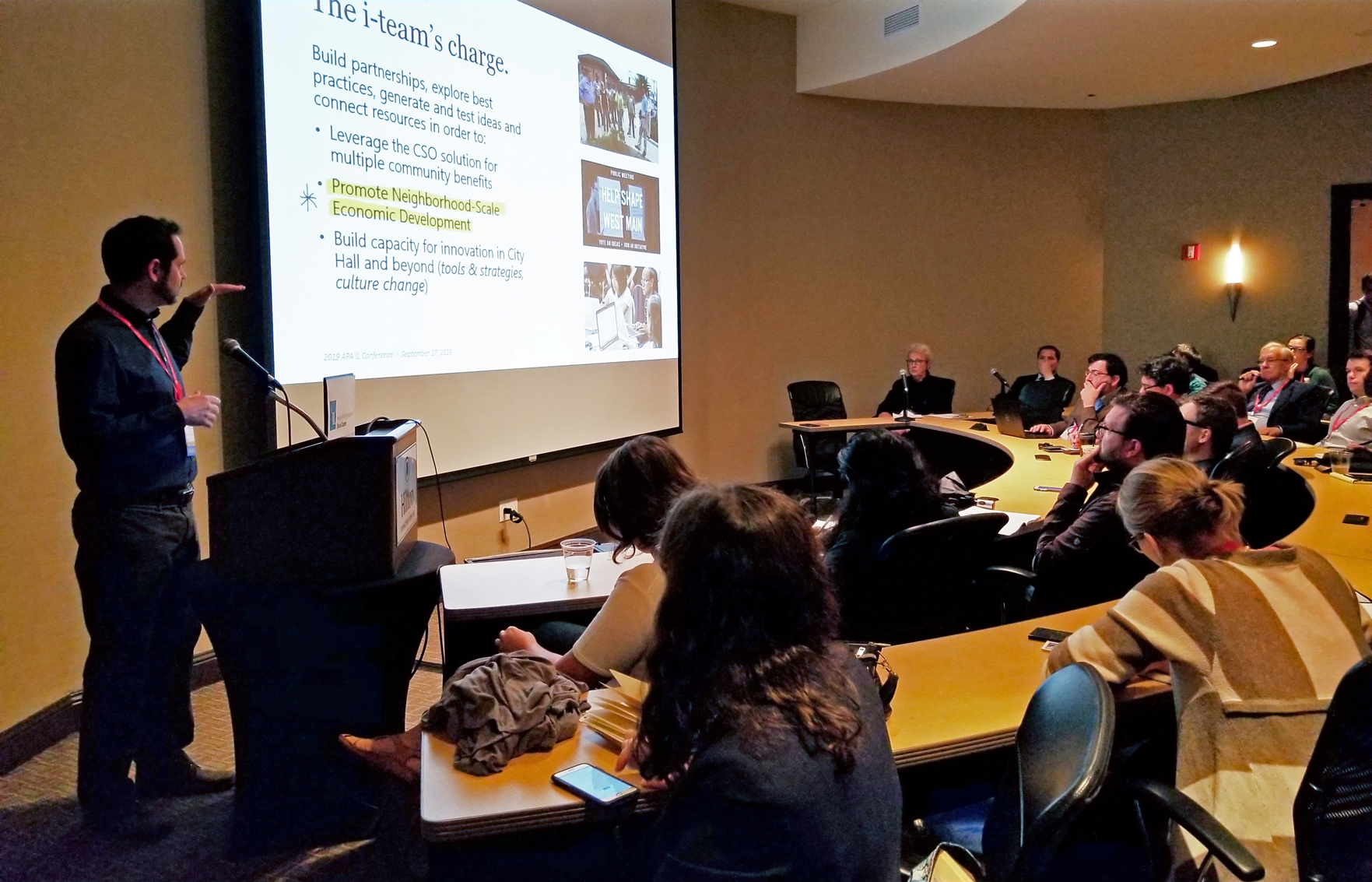The communities of Peoria, Lake Bluff and Albany Park seemingly have little in common, but all suffer from the same problem: a shortage of affordable owner-occupied housing.
Also, all three were winners of the Congress for New Urbanism Illinois’ “Missing in the Middle” design competition, which challenged communities to develop innovative ideas to help provide so-called missing middle properties, which aim to establish new ideas for housing options that bridge the gap between single-family homes and large multi-unit buildings. Learn more about the winners of the contest at CNU Illinois’ website.
Representatives of the three communities spoke to a standing-room-only crowd at the American Planning Association – Illinois Chapter’s annual conference in Evanston on Sept. 27, revealing the different challenges to affordable housing each area faces.
Infrastructure for empty spaces
Anthony Corso, the city of Peoria’s chief innovation officer, told conference attendees that the municipality initially applied for the missing middle grant because of the city’s combined sewer overflow problems.
“It’s something that we’ve been grappling with trying to solve,” he said, noting that part of the strategy for addressing the multimillion infrastructure problem focuses on redevelopment in neglected areas of the city. “We wanted things to be teed up to connect the dots, so that we were driving private reinvestment in those areas as well, and that’s where the conversation evolved.”
Peoria was the overall winner of the contest with its block-wide development designed by Providence, Rhode Island-based firm Union Studio Architecture & Community Design, which envisioned a development on vacant land that incorporates a combination of mixed-use, live-work and residential units.
Corso said past project proposals were scuttled by economic downturns in 2001 and 2008, prompting city planners to take a more incremental approach to development moving forward.
Peoria’s missing middle proposal also won the CNU’s Merit award for the Atlanta-based Historical Concepts’ mixed-use courtyard apartment building design. Corso noted that Peoria is home to two of the largest healthcare organizations in the state, which increases the need for such designs. “There’s actually a demand for those folks to have rental apartments and other things,” Corso said, “and the neighborhoods around [the healthcare organizations’ offices] are almost entirely single-family housing.”
Drawing attention to a dwindling housing stock
While Peoria had vacant land to deal with, the problem is completely different in the Albany Park neighborhood of Chicago. That’s according to community organizer Diane Limas, who said available land for new development is practically nonexistent.
She said affordable 2- to 4-flat buildings in the neighborhood, along with much of the rest of the city, are in decline. “The housing stock is an extremely important component of unsubsidized, lower-cost portion of the market that provides affordable housing for many residents across the city,” she said.
The neighborhood’s “Turning the Court” proposal by Astoria, New York-based architects Christopher Fagan and Nick Rolinski, offers smaller, affordable units and retail along with family-sized units. Limas, who represents the Albany Park community organization known as Communities United, said they hoped the contest would help shine a spotlight on the problem of affordable housing in the area.
“We felt the awareness of the missing middle contest would acknowledge that preservation, as well as the development of this kind of housing stock, is important to middle- and low-income families,” she said. “The time is now to start having these discussions.”
Countering opposition to development
In the suburban community of Lake Bluff, community opposition to new development is the greatest hurdle for village planners and developers, according to village administrator Drew Irvin.
Lake Bluff was also selected as a merit winner for its “Assembly Required” proposal by Kenilworth, Illinois-based Edward Deegan Architects, which the company described as a way to explore “innovative ideas for tactical retail, public corridor space and modular design.”
Irvin noted that less than 1 percent of the housing stock in the affluent community of about 6,000 is multifamily. “We wanted to try to introduce this kind of housing stock,” he said. Though he noted that “there is a desire for people to have it in our community,” he was also forthright about the fact that residents have opposed change in Lake Bluff. While village planners have worked to ease zoning in order to allow for such developments, the village board attached a 2-story height limit on new buildings, making it increasingly difficult to move forward with multi-unit developments.
Irvin echoed other speakers, saying village administrators view the contest as an opportunity to continue the dialogue with Lake Bluff residents about the potential for missing-middle developments.
